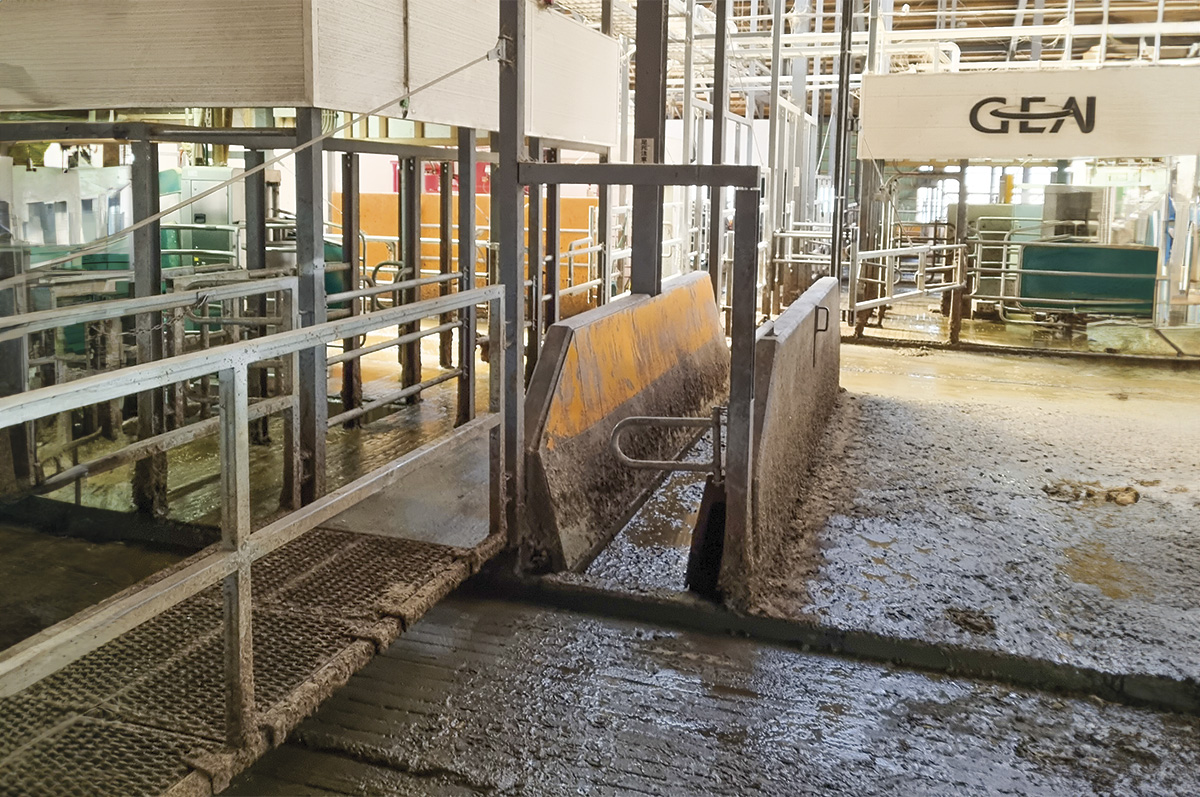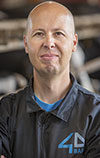Lameness in dairy cows is a significant issue that impacts cow health, productivity and overall farm profitability. In robotic milking systems, where cows need to move frequently to and from milking robots, lameness can severely disrupt operations. Lame cows often reduce their milking frequency, leading to decreased milk yield and potentially impacting their overall health and productivity. For these reasons, lameness affects a herd even more in a robot barn than in a conventional parlor barn.
Prevention is key
Preventing lameness is far more cost-effective and beneficial than treating it after it occurs. Investing in proper barn design and maintenance during the planning and construction phases can save significant costs and improve animal welfare in the long term. Key preventive measures include the implementation of well-designed flooring, comfortable lying areas and effective cooling systems.
Proper flooring is critical in preventing lameness. Concrete floors should be grooved or textured to minimize the risk of slipping. Ideal grooving patterns help reduce slips and falls, which are major contributors to lameness. In areas where cows frequently move, such as transfer alleys and the milking area, rubber flooring can significantly reduce the risk of slippage and improve cow comfort.
Providing ample, well-bedded lying areas encourages cows to rest rather than stand for prolonged periods. Comfortable resting areas reduce the risk of lameness by alleviating pressure on the hooves. Ensuring lying areas are dry and clean, with soft bedding materials such as sand or straw, is essential. Regular maintenance and replenishment of bedding materials are crucial to provide a comfortable resting environment for the cows.
During hot weather, cooling systems, such as fans and sprinklers, help reduce heat stress which can cause cows to stand excessively to avoid heat. Properly designed ventilation systems ensure adequate air circulation, keeping the barn environment comfortable and reducing the risk of lameness associated with prolonged standing due to heat stress.
Handling chute areas
Dedicated hoof-trimming areas for daily use
Hoof trimming and treatment should be conducted in dedicated areas designed for easy and safe handling of cows. These areas should have good lighting and traction. It is important to keep a cow’s instincts in mind when routes and gating are planned. Preferred handling areas are beside robot fetch pens. When these are correctly thought out, one person can handle all the tasks in the chute fluently, not dependent on the size of the barn. These facilities should include a holding area or a narrow alley for a few cows, allowing them to be moved in small groups for efficient handling.
In large facilities with several cow pens, the design challenge is to decide whether there will be one dedicated hoof trimming area for all pens or whether each pen has its own trim area. There is no right answer to this. It depends on the management choices and employee structure of a farm. It is suggested to have at least a simple handling chute to look at a cow’s hooves in the pen without moving her a long distance. If checking the cow’s hooves is easy, it gets done. It is important that people working in the cow pens first have an understanding to recognize lame cows but also do some basic tasks, such as applying blocks when applicable.
Proper layout and equipment for the contractor
Transfer lanes between barns are ideal spots for contracted hoof trimmers to set up. The layout should include features such as a bud box system, which facilitates cow flow and makes handling easier. Hydraulic chutes require access to electricity, and having a high-powered wash hose nearby is beneficial. Properly designed handling chutes reduce stress on the cows and handlers, making the trimming process smoother and more efficient. The setup should be at the other end of the barn opposite the robots to reduce stress on the herd and interference with milking robot traffic.
Well-organized footbaths
Effective placement and design
Footbaths are crucial in maintaining hoof health by preventing and controlling hoof diseases. Proper placement and design of footbaths are essential to ensure their effectiveness without interfering with cow traffic to and from the milking robots.
The best way to locate a footbath is a part of the robot exit. Cows get out from the robots, but to get to the stalls they need to walk through the footbath. This way, the footbath doesn’t block robot traffic if the cow is a bit hesitant to use it.
In some barns, the footbath is at the end of the barn and cows are pushed through it as a group. This can be one alternative, but as cows in a robot barn are not used to being moved as a group, this might create a hassle and cows running through the footbath too fast.
Footbaths should be long enough to ensure cows’ hooves are properly submerged for an adequate duration, allowing for thorough cleaning and treatment.

Proper placement and design of footbaths are essential to ensure their effectiveness without interfering with cow traffic to and from the milking robots. Photo courtesy of 4dBarn.
Maintenance and accessibility
Regular maintenance of footbaths ensures their efficacy. This includes cleaning and replenishing the solution as needed to maintain its effectiveness. Make footbaths easily accessible yet strategically placed to avoid disruption of the normal movement of cows within the facility. This helps maintain a smooth flow of cow traffic and reduces the risk of lameness caused by dirty or poorly maintained footbaths.
Efficient handling space in robotic milking facilities is essential to reduce lameness and improve overall herd health and productivity. By focusing on proper design, regular maintenance and the integration of advanced technologies, dairy farmers can create an environment that supports the well-being of their cows and enhances the efficiency of their operations. Key areas such as dedicated hoof care facilities, well-organized footbaths, comfortable lying areas, effective cooling systems, and proper flooring play a crucial role in minimizing lameness and ensuring the smooth operation of robotic milking facilities.
When designing a robotic milking facility, it is also crucial to work with partners who understand the importance of these preventative measures and can incorporate them into the design. A knowledgeable partner will consider all aspects of cow comfort and health, from hoof care facilities to the layout of feeding and resting areas, ensuring that the barn operates smoothly and efficiently while minimizing the risk of lameness. By staying informed and implementing best practices, dairy farmers can effectively manage lameness and enhance the overall productivity and welfare of their herds.












